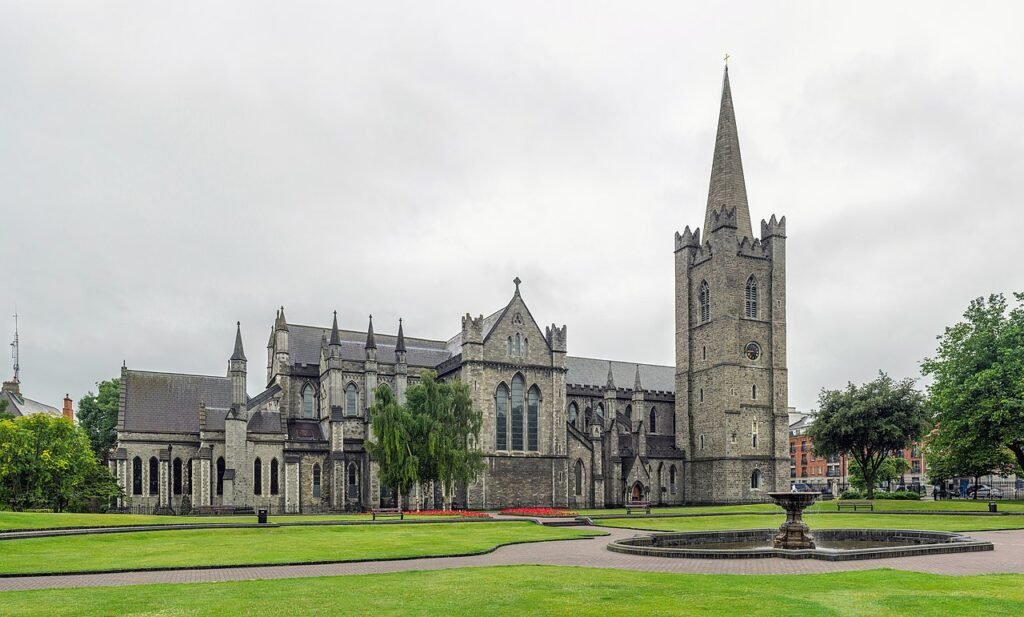17 Fascinating Facts about St Patrick Catholic Church in Dublin
St Patrick Catholic Church has been an unforgettable pilgrimage site for Christians for almost 1,000 years! So, if you’re wanting to visit St Patrick Catholic Church, aka Down Cathedral or St Patrick’s Cathedral, this post will give you everything you need to know.

What is special about St. Patrick’s Cathedral Dublin?
St Patrick Catholic Chuch in Dublin is a must-visit destination for anyone visiting Ireland’s capital city. It is a majestic building that boasts of Gothic architecture and rich history that dates back over 800 years. The church was founded in 1191 and has since played a vital role in Ireland’s religious and cultural life. It was also the site of many significant events, including the coronation of the last native High King of Ireland, Ruaidrí Ua Conchobair.
The church’s architecture is one of the most remarkable things about it. The building features a stunning medieval interior and exterior with beautiful stained glass windows, intricate carvings, and magnificent pillars. The church’s spire is also a standout feature, standing at an impressive height of 43 meters (141 feet) tall.
St Patrick Catholic Church in Dublin is also home to a beautiful park, which is a peaceful and tranquil place to visit. The park features a lovely fountain, benches, and well-manicured gardens that are perfect for picnics, relaxing, and taking in the beautiful scenery.
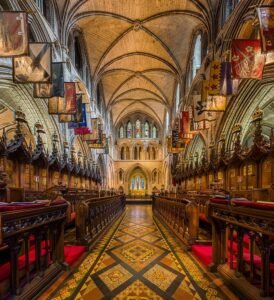
Why is St. Patrick important to the Catholic Church?
St. Patrick is an important figure in the Catholic Church and is widely recognized as the patron saint of Ireland.
He is celebrated on March 17th every year, with St. Patrick’s Day being a significant holiday in Ireland and across the world. St. Patrick is also credited with spreading Christianity across Ireland during the 5th century, converting many of the country’s pagan inhabitants to Christianity.

St. Patrick was also known for his devotion to God, his love for the people of Ireland, and his ability to perform miracles. His legacy lives on to this day, and he remains an important figure in Irish history and Catholicism.
What are 3 important facts about St. Patrick?
- St. Patrick was not actually Irish, but British. He was born in Scotland in the late 4th century and was brought to Ireland as a slave when he was 16 years old.
- St. Patrick is said to have used the three-leafed shamrock to explain the Holy Trinity to the people of Ireland. The shamrock has since become a symbol of Ireland and is often associated with St. Patrick’s Day.
- St. Patrick is credited with driving the snakes out of Ireland. However, there is no evidence that snakes ever existed in Ireland, and this is likely a metaphor for his efforts to rid the country of paganism and convert the people to Christianity.
St Patrick Catholic Church in Dublin is a magnificent building that attracts visitors from all over the world, and its architecture and history are truly impressive. St. Patrick is an important figure in the Catholic Church, and his legacy continues to inspire people today.
When did St. Patrick bring Catholicism to Ireland?
St. Patrick is credited with bringing Christianity to Ireland in the 5th century. Born in Britain, he was taken to Ireland as a slave when he was 16 years old.
During his captivity, he turned to Christianity for solace and eventually became a devout believer. After escaping from slavery and returning home to Britain, he felt a calling to return to Ireland as a missionary and spread the word of God.
St. Patrick spent the rest of his life traveling across Ireland, preaching the gospel, baptizing converts, and building churches. He used many techniques to reach out to the people of Ireland, including using the shamrock to explain the Holy Trinity. Over time, he converted many of the Irish people to Christianity and is credited with playing a significant role in the spread of Catholicism in Ireland.
What is Saint Patrick known for in Catholicism?
Saint Patrick is known for his deep devotion to God and his tireless efforts to spread Christianity throughout Ireland. He is also known for his humility, his love for the Irish people, and his ability to perform miracles.
One of the most famous stories about St. Patrick is the legend of him driving the snakes out of Ireland. Although there were never any snakes in Ireland, the story is seen as a metaphor for his efforts to rid the country of paganism and convert the people to Christianity.
St. Patrick is also known for his writings, particularly his Confessions, which provide insight into his life, beliefs, and mission. His legacy continues to inspire and guide Catholics around the world.
Where is St Patrick buried?
It’s important to note that there is no definitive answer to this question. The exact location of St Patrick’s grave is shrouded in mystery and subject to various interpretations and legends.
However, there are several theories and traditions that have developed over the centuries that suggest different possible burial sites for St Patrick.
One of the most widely accepted theories is that St Patrick is buried in Down Cathedral in Downpatrick, Northern Ireland. This is based on a tradition that dates back to the medieval period and is still celebrated today by the local community.
At St Patrick Catholic Church in Dublin you can see St. Patrick’s well too!
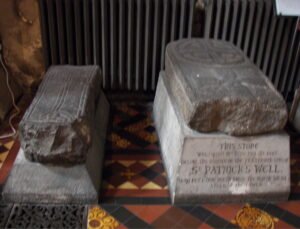
According to this tradition, St Patrick is buried alongside two other saints, Brigid and Columba, in a tomb that is marked by a large stone slab. This site is located within the cathedral’s grounds and is a popular destination for pilgrims and visitors from all over the world.
Another possible burial site for St Patrick is Saul Church, which is located near Downpatrick. This is where St Patrick is said to have built his first church in Ireland, and it is also where he is said to have died.
According to one legend, St Patrick was buried in a nearby hillside, which became known as Patrick’s Hill. Later, a church was built on this site, which eventually became known as Saul Church.
What is St. Patrick the patron saint of and why?
St. Patrick is the patron saint of Ireland, but he is also the patron saint of many other things, including engineers, paralegals, and snakebites. He is believed to have interceded in many miraculous events, including the protection of Ireland from invaders, the healing of the sick, and the calming of storms.
St. Patrick’s Day, which is celebrated on March 17th, is a significant holiday in Ireland and around the world. It is a day of celebration and remembrance of St. Patrick and his contributions to Catholicism and Irish culture.
St Patrick Catholic Church is a beautiful and historic landmark that represents the rich history and culture of Ireland. St. Patrick himself is an important figure in Catholicism and is known for his devotion to God, his love for the Irish people, and his efforts to spread Christianity throughout Ireland.
What is the history of St Patrick Catholic Church in Dublin?
St Patrick Catholic Church, located in Dublin, Ireland, is a magnificent structure that has been an important landmark in the city for centuries. Its construction began in 1191, but it was not completed until the early 14th century. The church is named after St. Patrick, the patron saint of Ireland, who is said to have baptized converts to Christianity at a nearby well in the 5th century.
Throughout its history, St Patrick Catholic Church has played an important role in the religious and cultural life of Dublin. It has been the site of many significant events, including the coronation of English monarchs, the signing of treaties, and the funeral of Irish writer Jonathan Swift.
The church has undergone many renovations and restorations over the years, including a major renovation in the 19th century that transformed it into the stunning Gothic structure that we see today.
In addition to its architectural beauty, St Patrick Catholic Church is also home to many works of art, including stained glass windows, statues, and paintings.
Is St. Patrick’s Cathedral a working church in Dublin Catholic?
St Patrick Catholic Church is still an active place of worship for the Christian community in Dublin.
While it is not a Catholic church at this time (more on that in a minute), it is a popular destination for tourists and locals alike, who come to admire its stunning architecture and learn about its rich history.
Church services are held regularly at St Patrick Catholic Church, and visitors are welcome to attend. The church also hosts many other events throughout the year, including concerts, lectures, and exhibitions.
St Patrick Catholic Church is a magnificent and historically significant structure that has been an important part of the religious and cultural life of Dublin for centuries. Its stunning Gothic architecture, rich history, and vibrant community make it a must-visit destination for anyone traveling to Ireland.

Is St. Patrick’s in Dublin a Catholic Church?
St Patrick Catholic Church, also known as St Patrick Catholic Church, was indeed a Catholic Church located in Dublin, Ireland. However, 500 years ago during the Protestant Reformation, that changed for this iconic church.
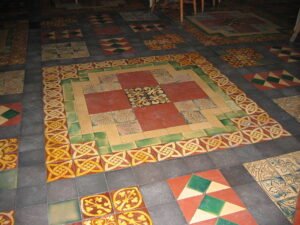
The Protestant Reformation and St. Patrick Catholic Church
The Protestant Reformation was a movement that began in the early 16th century in Europe. Led by figures such as Martin Luther and John Calvin, the movement sought to reform the Catholic Church and challenge its practices and teachings.
One of the major outcomes of the Reformation was the establishment of new Protestant denominations, which diverged from Catholicism in various ways. In Ireland, the Reformation took root in the 16th century under the rule of King Henry VIII, who sought to break away from the Catholic Church and establish the Church of England.
As part of this process, many Catholic churches in Ireland were confiscated and handed over to the Church of Ireland, the Anglican church established by Henry VIII. St Patrick Catholic Church in Dublin was one such church that was turned into a Protestant church.
The transition from Catholicism to Protestantism was not without controversy. Many Irish people, particularly in the south and west of the country, remained loyal to Catholicism and resisted the spread of Protestantism. This led to tensions and conflicts that continued for centuries.
The Legacy of St. Patrick Catholic Church
Unfortunately, St Patrick Catholic Church in Dublin remains a Protestant church today. You can attend church service there, but it ultimately won’t be a true “Sacrificial Mass” which is the ultimate thing to do for the sins to be forgiven.
Despite its conversion to Protestantism, St Patrick Catholic Church in Dublin remains a symbol of Ireland’s Catholic heritage and its connection to St. Patrick, the patron saint of Ireland. Many visitors to the cathedral come to learn about the life and legacy of St. Patrick, as well as to explore the cathedral’s art, architecture, and history.
The Protestant Reformation played a significant role in the transformation of St Patrick Catholic Church in Dublin into a Protestant church. Although the transition was not without controversy, the church remains a significant cultural and historical landmark in the city, and a symbol of Ireland’s Catholic heritage.
Whether you’re interested in history, architecture, or religious heritage, a visit to St Patrick Catholic Church in Dublin is well worth it.
St. Patrick’s Cathedral Dublin: Is it worth visiting?
Absolutely! St Patrick Catholic Church in Dublin is a must-see destination for anyone traveling to Dublin, whether you are a Catholic or not. It is one of the most stunning and historically significant structures in the city.
The cathedral’s Gothic architecture is breathtaking, with soaring ceilings, intricate stonework, and magnificent stained glass windows. Its interior is filled with beautiful works of art, including statues, paintings, and ornate carvings. The cathedral also has a rich history, having been the site of many significant events throughout the centuries.
Visitors can attend a church service at St Patrick Catholic Church, or simply wander around and admire its beauty. Guided tours are available, which provide visitors with a wealth of information about the history and significance of the cathedral.
St Patrick Catholic Church, or St. Patrick’s Cathedral, is an originally Catholic Church in Dublin is definitely worth visiting. Its stunning architecture, rich history, and vibrant community make it a must-see destination for anyone traveling to Ireland.
How to make a pilgrimage to St. Patrick Catholic Church
Let’s talk about how to make a pilgrimage to St Patrick Catholic Church, one of the most iconic structures in Dublin. Many people come from all over the world to visit this beautiful church, and we’re going to give you some tips on how to make the most of your pilgrimage.
- Plan ahead: Before you go, do some research on the church and its history. This will help you appreciate the significance of the church and make your pilgrimage more meaningful.
- Dress appropriately: As with any religious site, it’s important to dress modestly and respectfully. Avoid wearing shorts, tank tops, or anything too revealing.
- Attend a church service: If possible, attend a church service at St Patrick Catholic Church. This is a great way to experience the church’s spiritual significance and connect with the local Catholic community.
- Light a candle: Lighting a candle is a traditional way to show respect and offer prayers. There are many candle stands throughout the church where you can light a candle and offer your intentions.
- Take a guided tour: A guided tour of St Patrick Catholic Church is a great way to learn more about the history and significance of the church. Guided tours are available for a small fee, and they provide a wealth of information about the church and its art and architecture.
I love traveling and traveling to see the Saints is even better! I’ve personally been to St Patrick Catholic Church in Dublin and it was breathtaking.
While you’re in Dublin, why not look around?
I’ve put together a fun adventure for you HERE. Or, you can click on the picture below for more details.
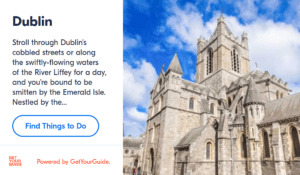
How much does it cost to visit St. Patrick’s Cathedral in Dublin?
The cost of visiting St Patrick Catholic Church varies depending on what you want to do. Attending a church service is free, but there is a fee for guided tours. The current fee for a guided tour is 8 EUR for adults, 6 EUR for seniors and students, and 4 EUR for children.
How long does it take to tour St. Patrick’s Cathedral in Dublin?
The length of your visit to St Patrick Catholic Church depends on how much time you have and what you want to do. Attending a church service usually takes about an hour, and a guided tour takes about 50 minutes. However, if you want to spend more time exploring the church on your own, you may want to budget a few hours for your visit.
visiting St Patrick Catholic Church is a wonderful way to connect with the history and spirituality of Ireland. By following these tips, you can make the most of your pilgrimage and have a meaningful and memorable experience.
What type of Church is St. Patrick Catholic Church?
The Gothic architecture of St Patrick Catholic Church reflects the Catholic faith, with its soaring ceilings, stained-glass windows, and ornate altars and decorations. The church is designed to create a sense of awe and reverence, drawing visitors into a deeper connection with God and the spiritual realm.
In addition to its spiritual significance, St Patrick Catholic Church is also a cultural and historical landmark in Dublin. It is one of the city’s most visited tourist attractions, with thousands of visitors each year coming to admire its architecture, art, and history.
St Patrick Catholic Church is a Roman Catholic church, designed to inspire awe and reverence in those who visit it. As a place of worship, prayer, and community, it plays a vital role in the lives of the Catholic faithful in Dublin and beyond. Whether you are a Catholic pilgrim or a curious tourist, a visit to St Patrick Catholic Church is sure to be a memorable and meaningful experience.
Should you go to Dublin for St. Patrick’s Day?
Should you go to Dublin for St. Patrick’s Day? Well, as a wise Irishman once said, “There are only two kinds of people in the world, the Irish and those who wish they were.” So, if you’re looking for an unforgettable St. Patrick’s Day experience, Dublin is the place to be! Let’s take a closer look at why.
The short answer is, absolutely! St. Patrick’s Day is a national holiday in Ireland, and Dublin is the epicenter of the celebrations. From parades to parties, there’s no shortage of fun and festive activities to enjoy. Plus, as the home of St. Patrick Catholic Church, Dublin is steeped in history and tradition, making it the perfect destination for a spiritual pilgrimage as well.
What is there to do in Dublin on St. Patrick’s Day?
Where do we even begin? The St. Patrick’s Festival in Dublin is a four-day celebration, featuring everything from music and dance performances to street theatre and family-friendly activities. Here are just a few of the highlights:
- The St. Patrick’s Day Parade: This iconic parade is the centerpiece of the festival, featuring floats, marching bands, and performers from all over the world. It’s a colorful and lively spectacle that’s not to be missed.
- The Greening of the City: To mark the occasion, many of Dublin’s landmarks and buildings are illuminated in green, including St. Patrick’s Cathedral and the Guinness Storehouse.
- Traditional Irish Music: If you’re a fan of traditional Irish music, Dublin is the place to be. From pub sessions to concerts, there are plenty of opportunities to enjoy live music throughout the festival.
- Food and Drink: What’s a celebration without food and drink? Dublin’s many pubs and restaurants offer a wide range of Irish delicacies, including corned beef and cabbage, Irish stew, and, of course, Guinness.
- St. Patrick’s Cathedral: And last but certainly not least, a visit to St. Patrick Catholic Church is a must-do for any Catholic pilgrim or history buff. Take a tour of this magnificent church, attend a church service, and reflect on the life and legacy of St. Patrick himself.
If you’re looking for an unforgettable St. Patrick’s Day experience, Dublin is the place to be. With its rich history, vibrant culture, and festive atmosphere, there’s no shortage of things to see and do. Whether you’re a Catholic pilgrim, a history buff, or simply looking to have some fun, Dublin is the perfect destination for St. Patrick’s Day. So, as the Irish say, “Erin go bragh!” (Ireland forever!)
Is there a St. Patrick Catholic Church near me?
The easiest way to find out is to search online. Simply type “St. Patrick Catholic Church near me” into your preferred search engine, and it should bring up a list of churches in your area. You can also check the Catholic Diocese website for your state or region, as they often have a directory of Catholic churches.
If you’re still having trouble finding a St. Patrick Catholic Church nearby, don’t worry! There may be other Catholic churches in your area that you can attend instead. You can also reach out to the nearest Catholic parish and inquire about the availability of masses or services.
Why attend a St. Patrick Catholic Church?
St. Patrick Catholic Church is a special place for Catholics all over the world. Not only is it dedicated to the patron saint of Ireland, but it also represents a long and rich tradition of Catholicism. Attending mass or services at a St. Patrick Catholic Church can be a meaningful and spiritual experience, allowing you to connect with your faith and community.
Additionally, St. Patrick Catholic Churches often have a strong sense of community and hospitality. They may offer various activities and events for parishioners, such as social gatherings, volunteer opportunities, and educational programs. These can be great ways to meet like-minded individuals and get involved in your local Catholic community.
Attending mass or services can be a meaningful and spiritual experience that allows you to connect with your faith and community. So, if you’re interested in exploring Catholicism or strengthening your faith, consider attending a St. Patrick Catholic Church or another Catholic parish in your area.
Are You Inspired?
Did you find inspiration in what you learned today? I honestly enjoy researching and talking about the lives of the saints.
You can wear the great blouse I made for you on the day that we celebrate St Patrick’s Day or when you’re out and about.
These t-shirts make it simpler to discuss saints with close friends, members of your family, and total strangers you meet on the street. Now, if someone comments on your shirt or inquires about it, you can tell them about the heroic story of St Patrick.
You might also invite them to church and share the gospel with them there. You can discuss the notion that everyone requires a savior, that Jesus is the blood sacrifice who came to atone for our sins, and how every one of us requires Him as our Savior.
Even better, you may invite them by signing them up for the RCIA classes your parish is providing.
On this one, I’ll be praying for you!
This image makes the shirt visible. Simply click it. After deciding on your preferred color and size, click the BUY NOW button to go to the checkout page.

For more great saints, visit our blog HERE.
Have a few more minutes to dive into another saint?
Why not learn about:
- 21 Extraordinary Facts of Our Lady of Lourdes & Pilgrimage
- St. Bernadette Soubirous: Discover 15 Facts about her Saintly Life
- St. Romuald: 11 Reflective Aspects about His Life
- 14 Fascinating Facts about St. Scholastica
Did you know that you may join us every day as we learn more about the Saint of the Day? If you’d like to receive my daily saint emails in your inbox, kindly take a moment to subscribe. Since I know you’re busy, I’ll make it short, but I truly want you to learn a lot so you can have the same experience as me and reside among the saints.
I’ll also throw in a free screen saver for your phone as a bonus. After you submit the form, I’ll email you the download link for the new screensaver. Enjoy!
Well, that’s all for today.
I’ll see you back tomorrow with another Saint of the Day to inspire you!
God bless you,
-Priscilla

